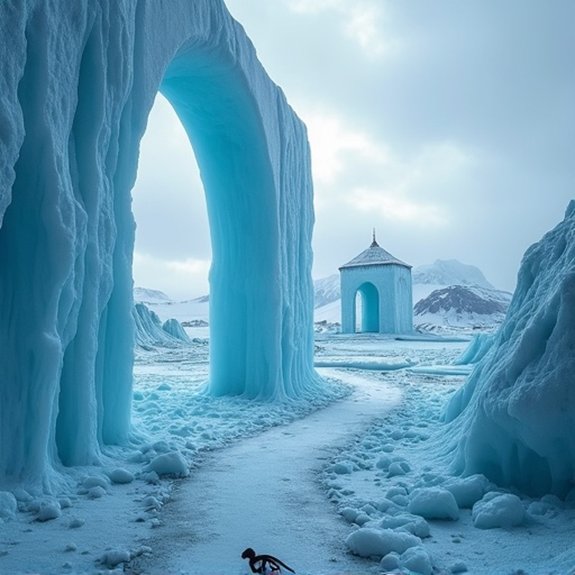The Frozen Cities Beneath Greenland
Beneath Greenland’s ice sheet, abandoned military installations from the Cold War era tell a troubling story. Camp Century’s nuclear-powered tunnels and mysterious geometric patterns detected by radar aren’t just historical curiosities—they’re ticking environmental time bombs. As climate change accelerates the ice’s retreat, these frozen cities threaten to release decades-old hazardous waste into pristine Arctic waters. What other secrets lie buried beneath two miles of ice?
Introduction

While Greenland’s massive ice sheet appears as nothing more than a frozen wasteland from above, it conceals one of the Cold War’s most extraordinary engineering achievements. Deep beneath the ice lies Camp Century, a nuclear-powered military base the U.S. Army constructed in 1959. Engineers carved this “city under ice” directly into the glacier, creating a network of tunnels spanning three kilometers.
The base housed up to 200 soldiers and featured remarkable amenities: a theater, chapel, hospital, and laboratories. Scientists conducted Arctic research while the military tested construction techniques for potential missile sites. Though abandoned in 1967 when shifting ice threatened its stability, Camp Century’s frozen remains still exist today. Climate change now threatens to expose the base’s buried infrastructure and toxic waste, transforming this relic into an emerging environmental concern.
Cold War Military Installations
Although Camp Century captures the imagination as a frozen time capsule, it represented just one component of America’s extensive Arctic military network during the Cold War. The U.S. military constructed dozens of installations across Greenland’s ice sheet between 1951 and 1967, transforming the frozen wilderness into a strategic defense frontier.
These bases served multiple purposes: early warning radar stations detected Soviet bombers, weather stations tracked Arctic conditions, and research facilities studied ice dynamics. The military’s largest permanent installation, Thule Air Base, housed over 10,000 personnel at its peak. Engineers built ice tunnels, underground fuel depots, and even considered Project Iceworm—a planned network of 2,500 miles of tunnels concealing 600 nuclear missiles beneath the ice. Though Iceworm never materialized, its infrastructure remains buried, slowly crushed by glacial movement.
Notable Cases or Sightings

Pilots flying over Greenland’s interior have reported strange geometric patterns visible through the ice since the 1970s. These sightings typically occur during clear weather when sunlight penetrates the upper ice layers at specific angles. In 1992, a NASA survey team documented what appeared to be rectangular structures approximately 200 feet below the surface near Camp Century’s original location.
Scientists using ground-penetrating radar have detected numerous anomalies that don’t match natural ice formations. The most significant discovery came in 2016 when researchers found intact tunnels containing abandoned equipment and thousands of barrels of waste. Thermal imaging has revealed heat signatures suggesting some structures maintain temperatures above the surrounding ice. Danish geological surveys have mapped at least twelve sites showing similar characteristics, though accessing these locations remains impossible due to ice thickness.
Common Theories or Explanations
These documented anomalies have sparked numerous theories about what lies beneath Greenland’s ice sheet. Scientists propose that geometric patterns detected by radar might be natural crystalline formations created by extreme pressure and temperature cycles. Geologists argue the structures could be ancient volcanic features or mineral deposits that’ve assumed city-like configurations through millennia of geological processes.
Alternative researchers suggest they’re remnants of pre-ice age civilizations, pointing to similar discoveries in Antarctica. Some theorists connect the formations to Norse legends of hidden lands beyond the northern ice. Military analysts haven’t ruled out Cold War installations, noting several confirmed bases were abandoned during the 1960s.
The most controversial explanation involves extraterrestrial origins, with proponents citing the structures’ mathematical precision and alignment with celestial bodies.
Frequently Asked Questions
What Environmental Hazards Do These Abandoned Frozen Cities Pose Today?
These abandoned frozen cities don’t pose significant environmental hazards today. They’re entombed in ice, containing any potential contaminants. Scientists monitor them for structural collapse risks, but the extreme cold preserves materials and prevents chemical leaching.
How Much Would It Cost to Excavate and Remove These Installations?
Engineers estimate it’d cost billions of dollars to excavate and remove Camp Century and similar installations from Greenland’s ice sheet. The extreme conditions, remote locations, and hazardous materials would make cleanup operations extraordinarily expensive and complex.
Are Tourists Allowed to Visit Any of These Frozen City Sites?
No, tourists can’t visit these frozen military installations beneath Greenland’s ice. They’re completely abandoned, structurally unsafe, and buried under decades of accumulated snow and ice. The sites remain off-limits for safety and environmental protection reasons.
What Happens to the Structures as Climate Change Melts the Ice?
As Greenland’s ice melts, the abandoned structures collapse under shifting ice pressure. They’re gradually crushed, deformed, and compressed into unrecognizable debris. Eventually, they’ll either remain buried in refrozen ice or emerge as twisted metal ruins.
Who Legally Owns These Abandoned Facilities Under International Law?
Denmark owns these abandoned facilities as Greenland’s sovereign authority, though the U.S. military built them. International law hasn’t fully resolved liability issues, especially regarding waste cleanup responsibilities. Greenland’s growing autonomy further complicates ownership questions.


